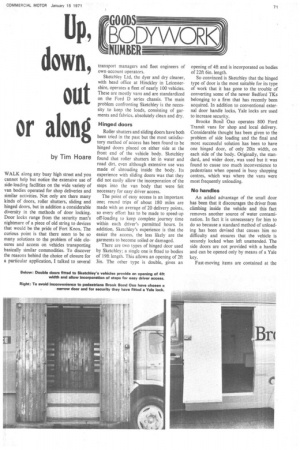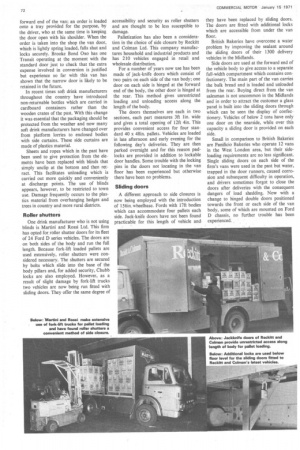Up down, out or along
Page 75

Page 76

If you've noticed an error in this article please click here to report it so we can fix it.
by Tim Hoare
WALK along any busy high street and you cannot help but notice the extensive use of side-loading facilities on the wide variety of van bodies operated for shop deliveries and similar activities. Not only are there many kinds of doors, roller shutters, sliding and hinged doors, but in addition a considerable diversity in the methods of door locking. Door locks range from the security man's nightmare of a piece of old string to devices that would be the pride of Fort Knox. The curious point is that there seem to be so many solutions to the problem of side closures and access on vehicles transporting basically similar commodities. To discover the reasons behind the choice of closure for a particular application, I talked to several transport managers and fleet engineers of own-account operators.
Sketchley Ltd, the dyer and dry cleaner, with head office at Hinckley in Leicestershire, operates a fleet of nearly 100 vehicles. These are mostly vans and are standardized on the Ford D series chassis. The main problem confronting Sketchley is the necessity to keep the loads, consisting of garments and fabrics, absolutely clean and dry.
Hinged doors
Roller shutters and sliding doors have both been tried in the past but the most satisfactory method of access has been found to be hinged doors placed on either side at the front end of the vehicle body. Sketchley found that roller shutters let in water and road dirt, even although extensive use was made of shrouding inside the body. Its experience with sliding doors was that they did not easily allow the incorporation of the steps into the van body that were felt necessary for easy driver access.
The point of easy access is an important one; round trips of about 180 miles are made with an average of 20 delivery points, so every effort has to be made to speed-up off-loading to keep complete journey time within each driver's permitted hours. In addition, Sketchley's experience is that the easier the access, the less likely are the garments to become soiled or damaged.
There are two types of hinged door used by Sketchley: a single one is fitted to bodies of 19ft length. This allows an opening of 2ft 3in. The other type is double, gives an opening of 4ft and is incorporated on bodies of 22ft 6in. length.
So convinced is Sketchley that the hinged type of door is the most suitable for its type of work that it has gone to the trouble of converting some of the newer Bedford TKs belonging to a firm that has recently been acquired. In addition to conventional external door handle locks, Yale locks are used to increase security.
Brooke Bond Oxo operates 800 Ford Transit vans for shop and local delivery. Considerable thought has been given to the problem of side loading and the final and most successful solution has been to have one hinged door, of only 20in width, on each side of the body. Originally, the standard, and wider door, was used but it was found to cause too much inconvenience to pedestrians when opened in busy shopping centres, which was where the vans were most frequently unloading.
No handles
An added advantage of the small door has been that it discourages the driver from climbing inside the vehicle and this fact removes another source of water contamination. In fact it is unnecessary for him to do so because a standard method of unloading has been devised that causes him no difficulty and ensures that the vehicle is securely locked when left unattended, The side doors are not provided with a handle and can be opened only by means of a Yale key.
Fast-moving items are contained at the forward end of the van; an order is loaded onto a tray provided for the purpose, by the driver, who at the same time is keeping the door open with his shoulder. When the order is taken into the shop the van door, which is lightly spring loaded, falls shut and locks securely. Brooke Bond Oxo has one Transit operating at the moment with the standard door just to check that the extra expense involved in conversion is justified but experience so far with this van has shown that the narrow door is likely to be retained in the future.
In recent times soft drink manufacturers throughout the country have introduced non-returnable bottles which are carried in cardboard containers rather than the wooden crates of the past. With this change it was essential that the packaging should be protected from the weather and now many soft drink manufacturers have changed over from platform lorries to enclosed bodies with side curtains. These side curtains are made of plastics material.
Sheets and ropes which in the past have been used to give protection from the elements have been replaced with blinds that simply unclip at the bottom and then retract. This facilitates unloading which is carried out more quickly and conveniently at discharge points. The use of blinds appears, however, to be restricted to town use. Damage frequently occurs to the plastics material from overhanging hedges and trees in country and more rural districts.
Roller shutters One drink manufacturer who is not using blinds is Martini and Rossi Ltd. This firm has opted for roller shutter doors for its fleet of 24 Ford D series vehicles. The doors are on both sides of the body and run the full length. Because fork-lift loaded pallets are used extensively, roller shutters were considered necessary. The shutters are secured by bolts which slide into the base of the body pillars and, for added security, Chubb locks are also employed. However, as a result of slight damage by fork-lift trucks two vehicles are now being run fitted with sliding doors. They offer the same degree of accessibility and security as roller shutters and are thought to be less susceptible to damage.
Palletization has also been a consideration in the choice of side closure by Reckitt and Colman Ltd. This company manufactures household and industrial products and has 210 vehicles engaged in retail and wholesale distribution.
For a number of years now use has been made of jack-knife doors which consist of two pairs on each side of the van body; one door on each side is hinged at the forward end of the body, the other door is hinged at the rear. This method gives unrestricted loading and unloading access along the length of the body.
The doors themselves are each in two sections, each part measures 3ft lin. wide and gives a total opening of 12ft 4in. This provides convenient access for four standard 40 x 48in. pallets. Vehicles are loaded in late afternoon and early evening for the following day's deliveries. They are then parked overnight and for this reason padlocks are provided in addition to lockable door handles. Some trouble with the locking pins in the doors not locating in the van floor has been experienced but otherwise there have been no problems.
Sliding doors A different approach to side closures is now being employed with the introduction of 156in. wheelbase. Fords with lift bodies which can accommodate four pallets each side. Jack-knife doors have not been found practicable for this length of vehicle and they have been replaced by sliding doors. The doors are fitted with additional locks which are accessible from under the van floor.
British Bakeries have overcome a water problem by improving the sealant around the sliding doors of their 1300 delivery vehicles in the Midlands.
Side doors are used at the forward end of the vehicle body to give access to a separate full-width compartment which contains confectionery. The main part of the van carries the bulk bread and is loaded and unloaded from the rear. Buying direct from the van salesman is not uncommon in the Midlands and in order to attract the customer a glass panel. is built into the sliding doors through which can be seen the display of confectionery. Vehicles of below 2 tons have only one door on the nearside, while over this capacity a sliding door is provided on each side.
Small in comparison to British Bakeries are Panificio Bakeries who operate 12 vans in the West London area, but their sideloading requirements are no less significant. Single sliding doors on each side of the firm's vans were used in the past but water, trapped in the door runners, caused corrosion and subsequent difficulty in operation, and drivers sometimes forgot to close the doors after deliveries with the consequent dangers of load shedding. Now with a change to hinged double doors positioned towards the front or each side of the van body, some of which are mounted on Ford D chassis, no further trouble has been experienced.




































































































































